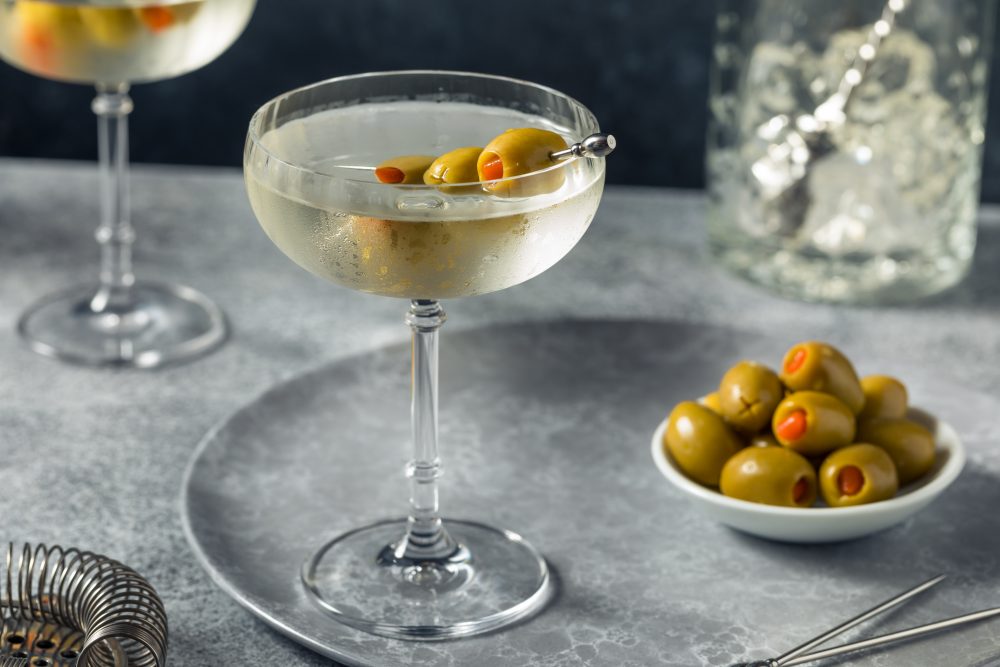Taking a few moments to understand vermouth will help you make better-tasting martinis, but it’s only one part of the equation. For a deeper understanding of the various martini styles—including extra-dry, wet, and 50/50— join martini experts and cocktail book authors Sebastian Hamilton-Mudge, Natalia Garcia Bourke and Andy Shannon on December 6 at Milk Street Cooking School to learn the history of the classic cocktail, play around with recipes and craft your version of the “perfect” martini.
What is vermouth?
Vermouth is a flavored fortified wine that descends from 18th century medicinal wines. It gets its name from the German word “vermut,” which translates to “wormwood,” the primary flavoring ingredient.
The spectrum of vermouth colors and flavors is vast and ever-expanding, but there are a few essential styles you should be familiar with as a cocktail drinker: dry vermouth, which is clear and colorless and used in martinis, vespers, and kangaroos (vodka martinis); sweet (red) vermouth, the vermouth you’ll need when making a Manhattan or Negroni; and bianco vermouth, which is clear but straw-colored, and sweeter than white vermouth, and what I use when I’m playing around with sweeter martini variations.
Though there are a few exceptions, most modern vermouth is made with neutral white wine grapes and fortified for an A.B.V of around 16-18%. It’s flavored with a wide range of herbs and other botanicals, and each producer makes theirs a little differently. Dry vermouth has little to no sugar added, is lean, crisp, tart, and floral, and tastes great with gin and vodka. Sweet red vermouth is (obviously) sweetened, as is bianco. Unlike red wine, red vermouth gets its color not from grapes, but from caramelized sugar.
How to choose a vermouth
The most straightforward way to choose a vermouth is to match the style to your drink and grab a bottle of what’s called for in the recipe. Dolin is a popular brand, and the one I reach for the most, though Martini & Rossi and Cinzano are ubiquitous and serviceable, especially if you seek out their premium lines.
When making a martini, you’ll want a dry vermouth. Our editorial director, J.M. Hirsch, uses Martini & Rossi in his extra dirty freezer-door martini, and if it’s good enough for J.M., it’s good enough for me. He’ll also be teaching a class on freezer-door cocktails on December 12, where you can learn how to batch, bottle, and store large-format beverages for easy holiday entertaining, including martini variations like the lemon drop and espresso martini.
I like sipping on chilled vermouth as an aperitif, so I’ll usually buy something that I enjoy all on its own. This makes for the best-tasting martini, but also gives me a low-proof option I can sip on a Tuesday night while preparing dinner. Vermouth is often sold in small bottles, so try a few, both on their own and in cocktails.
How to care for your vermouth
I have a theory that the anti-vermouth sentiment of the late 90s can be traced to improperly stored vermouth. I once knew someone who stored theirs on top of a fridge; it did not taste good. Though it is a fortified wine, it is still a wine, and wine begins to change the moment you open the bottle.
There are two main culprits: bacteria and oxygen. The former is a lesser issue; though bacteria thrive in warm, moist environments, ethanol (the alcohol we drink) is antimicrobial, and vermouth is fortified with extra ethanol, making it a little heartier than a bottle of chardonnay. But if given enough time and stored improperly, those little beasties will eat the sugars in your vermouth, creating acetic acid and turning your fortified wine into fortified vinegar. This isn’t much of a concern with dry vermouth, as it has very little available sugar for the bacteria to munch on. Still, it’s good to be aware.
Oxidation is the bigger problem. Once that bottle is open, oxygen makes its way in, and starts changing the terpenes, esters, and other aromatic compounds responsible for the flavor in your vermouth. It does this by stealing electrons, but you don’t have to know how to balance a redox reaction to stave off its ill effects. (The phenols in red wine act as antioxidants, but again: even red vermouth is made with white wine, so they won’t be around to help out.)
The easiest way to keep your vermouth martini-worthy is to get if off of the bar cart and into the refrigerator. Cold temperatures dramatically slow physical and chemical reactions, and storing vermouth in the fridge will prevent oxidization (and microbial growth) for at least a month.
If you go through vermouth at a healthy clip, buy two small bottles instead of one large one, to limit the amount of oxygen introduced to your supply. Also try to minimize how often you open the bottle. If you know you’re going to be making more than one martini, you can pour out the amount you need for the evening and use that portion, rather than returning to the bottle each time. Your martini will be the better for it, and you can turn your attention to the finer details, like garnishes. I personally refuse to choose between olives and lemon zest. Why not both?
Image: Brent Hofacker
Join the conversation on Facebook, Instagram, TikTok and Pinterest.
And if you're looking for more Milk Street, check out our livestream cooking classes with our favorite chefs, home cooks and friends for global recipes, cooking methods and more.




